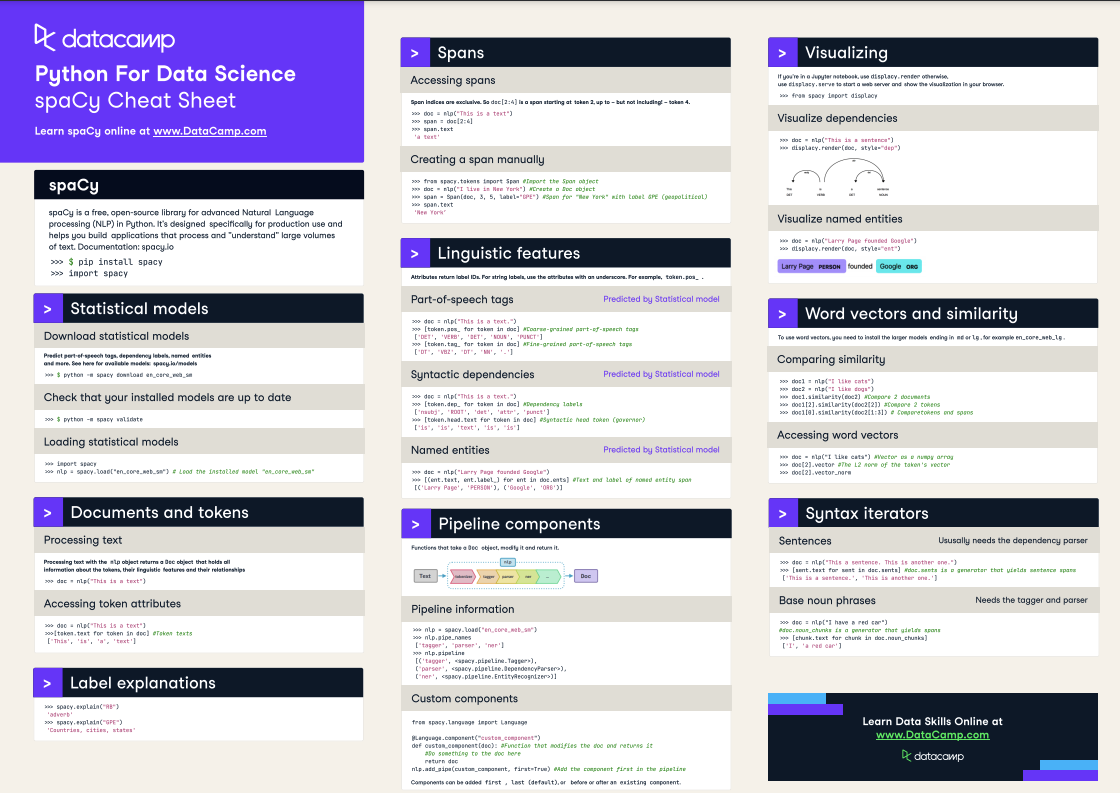Track
Natural Language Processing (NLP) stands as a pivotal technology in the realm of artificial intelligence, bridging the gap between human communication and computer understanding. It is a multidisciplinary domain that empowers computers to interpret, analyze, and generate human language, enabling seamless interaction between humans and machines. The significance of NLP is evident in its widespread applications, ranging from automated customer support to real-time language translation.
This article aims to provide newcomers with a comprehensive overview of NLP, its workings, applications, challenges, and future outlook.
What is Natural Language Processing?
Natural Language Processing (NLP) is a branch of artificial intelligence that focuses on the interaction between computers and humans through natural language. The objective is to program computers to process and analyze large amounts of natural language data.
NLP involves enabling machines to understand, interpret, and produce human language in a way that is both valuable and meaningful. OpenAI, known for developing advanced language models like ChatGPT, highlights the importance of NLP in creating intelligent systems that can understand, respond to, and generate text, making technology more user-friendly and accessible.
How Does NLP Work?
Let’s take a look at some of the mechanisms at work behind natural language processing. We’ve provided links to resources that can help you learn more about some of these key areas. For a detailed exploration, check out our Natural Language Processing in Python skill track.
Components of NLP
Natural Language Processing is not a monolithic, singular approach, but rather, it is composed of several components, each contributing to the overall understanding of language. The main components that NLP strives to understand are Syntax, Semantics, Pragmatics, and Discourse.
Syntax
- Definition: Syntax pertains to the arrangement of words and phrases to create well-structured sentences in a language.
- Example: Consider the sentence "The cat sat on the mat." Syntax involves analyzing the grammatical structure of this sentence, ensuring that it adheres to the grammatical rules of English, such as subject-verb agreement and proper word order
Semantics
- Definition: Semantics is concerned with understanding the meaning of words and how they create meaning when combined in sentences.
- Example: In the sentence "The panda eats shoots and leaves," semantics helps distinguish whether the panda eats plants (shoots and leaves) or is involved in a violent act (shoots) and then departs (leaves), based on the meaning of the words and the context.
Pragmatics
- Definition: Pragmatics deals with understanding language in various contexts, ensuring that the intended meaning is derived based on the situation, speaker’s intent, and shared knowledge.
- Example: If someone says, "Can you pass the salt?" Pragmatics involves understanding that this is a request rather than a question about one's ability to pass the salt, interpreting the speaker’s intent based on the dining context.
Discourse
- Definition: Discourse focuses on the analysis and interpretation of language beyond the sentence level, considering how sentences relate to each other in texts and conversations.
- Example: In a conversation where one person says, "I’m freezing," and another responds, "I’ll close the window," discourse involves understanding the coherence between the two statements, recognizing that the second statement is a response to the implied request in the first.
Understanding these components is crucial for anyone delving into NLP, as they form the backbone of how NLP models interpret and generate human language.
NLP techniques and methods
To analyze and understand human language, NLP employs a variety of techniques and methods. Here are some fundamental techniques used in NLP:
- Tokenization. This is the process of breaking text into words, phrases, symbols, or other meaningful elements, known as tokens.
- Parsing. Parsing involves analyzing the grammatical structure of a sentence to extract meaning.
- Lemmatization. This technique reduces words to their base or root form, allowing for the grouping of different forms of the same word.
- Named Entity Recognition (NER). NER is used to identify entities such as persons, organizations, locations, and other named items in the text.
- Sentiment analysis. This method is used to gain an understanding of the sentiment or emotion conveyed in a piece of text.
Each of these techniques plays a vital role in enabling computers to process and understand human language, forming the building blocks of more advanced NLP applications.
What is NLP Used For?
Now that we have some of the basic concepts defined, let’s take a look at how natural language processing is used in the modern world.
Industry applications
Natural Language Processing has found extensive applications across various industries, revolutionizing the way businesses operate and interact with users. Here are some of the key industry applications of NLP.
Healthcare
NLP assists in transcribing and organizing clinical notes, ensuring accurate and efficient documentation of patient information. For instance, a physician might dictate their notes, which NLP systems transcribe into text. Advanced NLP models can further categorize the information, identifying symptoms, diagnoses, and prescribed treatments, thereby streamlining the documentation process, minimizing manual data entry, and enhancing the accuracy of electronic health records.
Finance
Financial institutions leverage NLP to perform sentiment analysis on various text data like news articles, financial reports, and social media posts to gauge market sentiment regarding specific stocks or the market in general. Algorithms analyze the frequency of positive or negative words, and through machine learning models, predict potential impacts on stock prices or market movements, aiding traders and investors in making informed decisions.
Customer Service
NLP-powered chatbots have revolutionized customer support by providing instant, 24/7 responses to customer inquiries. These chatbots understand customer queries through text or voice, interpret the underlying intent, and provide accurate responses or solutions. For instance, a customer might inquire about their order status, and the chatbot, integrating with the order management system, retrieves and delivers the real-time status, enhancing customer experience and reducing support workload.
E-Commerce
NLP significantly enhances on-site search functionality in e-commerce platforms by understanding and interpreting user queries, even if they are phrased in a conversational manner or contain typos. For example, if a user searches for “blu jeens,” NLP algorithms correct the typos and understand the intent, providing relevant results for “blue jeans,” thereby ensuring that users find what they are looking for, even with imprecise queries.
Legal
In the legal sector, NLP is utilized to automate document review processes, significantly reducing the manual effort involved in sifting through vast volumes of legal documents. For instance, during litigation, legal professionals need to review numerous documents to identify relevant information. NLP algorithms can scan through these documents, identify and highlight pertinent information, such as specific terms, dates, or clauses, thereby expediting the review process and ensuring that no critical information is overlooked.
Everyday applications
Beyond industry-specific applications, NLP is ingrained in our daily lives, making technology more accessible and user-friendly. Here are some everyday applications of NLP:
- Search engines. NLP is fundamental to the functioning of search engines, enabling them to understand user queries and provide relevant results.
- Virtual assistants. Siri, Alexa, and Google Assistant are examples of virtual assistants that use NLP to understand and respond to user commands.
- Translation services. Services like Google Translate employ NLP to provide real-time language translation, breaking down language barriers and fostering communication.
- Email filtering. NLP is used in email services to filter out spam and categorize emails, helping users manage their inboxes more effectively.
- Social media monitoring. NLP enables the analysis of social media content to gauge public opinion, track trends, and manage online reputation.
The applications of NLP are diverse and pervasive, impacting various industries and our daily interactions with technology. Understanding these applications provides a glimpse into the transformative potential of NLP in shaping the future of technology and human interaction.
Challenges and The Future of NLP
Although natural language processing is an incredibly useful tool, it’s not without it flaws. Here, we look at some of the challenges we need to overcome, as well as what the future holds for NLP.
Overcoming NLP challenges
Natural Language Processing, despite its advancements, faces several challenges due to the inherent complexities and nuances of human language. Here are some of the challenges in NLP:
- Ambiguity. Human language is often ambiguous, with words having multiple meanings, making it challenging for NLP models to interpret the correct meaning in different contexts.
- Context. Understanding the context in which words are used is crucial for accurate interpretation, and it remains a significant challenge for NLP.
- Sarcasm and irony. Detecting sarcasm and irony is particularly challenging as it requires understanding the intended meaning, which may be opposite to the literal meaning.
- Cultural nuances. Language is deeply intertwined with culture, and understanding cultural nuances and idioms is essential for effective NLP.
Researchers and developers are continually working to overcome these challenges, employing advanced machine learning and deep learning techniques to enhance the capabilities of NLP models and make them more adept at understanding human language.
Check out our advanced NLP with spaCy course to discover how to build advanced natural language understanding systems using machine learning approaches.

The spaCy cheat sheet shows some advanced NLP techniques
The future of NLP
The future of Natural Language Processing is promising, with ongoing research and developments poised to further enhance its capabilities and applications. Here are some emerging trends and future developments in NLP:
- Transfer learning. The application of transfer learning in NLP allows models to apply knowledge learned from one task to another, improving efficiency and learning capability.
- Multimodal NLP. Integrating NLP with visual and auditory inputs will lead to the development of more versatile and comprehensive models capable of multimodal understanding.
- Real-time processing. Advancements in NLP will enable real-time language processing, allowing for more dynamic and interactive applications.
- Ethical and responsible AI. The focus on ethical considerations and responsible AI will shape the development of NLP models, ensuring fairness, transparency, and accountability.
The exploration of challenges provides insights into the complexities of NLP, while the glimpse into the future highlights the potential advancements and the evolving landscape of Natural Language Processing.
Getting Started with NLP
Learning resources
For those eager to delve into Natural Language Processing, DataCamp offers a range of courses and tutorials specifically designed to provide in-depth knowledge and hands-on experience in NLP. Here are some examples:
- Introduction to Natural Language Processing in Python Course. This course covers NLP basics such as identifying and separating words and extracting topics in a text.
- Introduction to Natural Language Processing in R. Another course covering NLP, this time with a focus on the R Programming language.
- Natural Language Processing in Python Track. This track helps you gain the core NLP skills needed to convert unstructured data into valuable insights.
- Advanced NLP with spaCy Course. This course is ideal for learning how to build advanced natural language understanding systems using both rule-based and machine learning approaches with spaCy.
- NLP With PyTorch: A Comprehensive guide. This tutorial covers NLP in PyTorch, a popular open-source machine learning library which provides robust tools for NLP tasks.
- NLP Tutorial with Google BERT. This tutorial covers the basics of NLP and how to use Google BERT to process text datasets.
- Deep Learning with PyTorch course. Here, you’ll start with an introduction to PyTorch, exploring the PyTorch library and its applications for neural networks and deep learning, essential parts of NLP.
- NLP Projects. This article provides NLP project suggestions for all levels.
These courses, along with other tutorials available on DataCamp, can provide newcomers with the foundational knowledge and practical skills needed to explore and contribute to the field of Natural Language Processing.
Final Thoughts
Natural Language Processing is a revolutionary field in artificial intelligence, enabling computers to understand, interpret, and generate human language, thereby fostering seamless interactions between humans and machines.
This article has traversed the realms of NLP, providing insights into its definition, components, techniques, applications, challenges, and the future landscape. The applications of NLP are multifaceted, spanning across various industries and embedding into our daily technological interactions, making it a crucial aspect of modern AI.
For those intrigued by the capabilities and potential of NLP, a journey of exploration and learning awaits. DataCamp’s Natural Language Processing in Python Track is an excellent starting point to delve deeper into this transformative domain.

A senior editor in the AI and edtech space. Committed to exploring data and AI trends.
FAQs
What is Natural Language Processing (NLP) in one sentence?
NLP is a field of artificial intelligence that focuses on enabling machines to understand, interpret, and respond to human language in a valuable way.
How is NLP different from AI?
NLP is a subset of AI focused specifically on enabling computers to understand, interpret, and generate human language in a meaningful way. While AI encompasses a broad range of technologies that allow machines to simulate human intelligence, including learning, reasoning, and problem-solving, NLP deals with linguistic elements. The main difference lies in their scope: AI is the broader discipline that aims to create intelligent machines, and NLP is a specialized area within AI dedicated to bridging the gap between human communication and computer understanding.
Do search engines like Google use NLP?
Yes, search engines like Google use NLP extensively to understand and process user queries, as well as to index and retrieve web content more effectively. NLP allows these search engines to grasp the context of words in search queries, improving the accuracy of search results.
Does ChatGPT use NLP?
Yes, ChatGPT uses advanced NLP technologies to understand and generate human-like text responses. It's built on models that analyze vast amounts of text data, learning patterns and nuances of language to simulate natural conversation.
What are the ethical considerations in using NLP?
Ethical issues include ensuring privacy, avoiding bias in language models, and ensuring that NLP applications do not misinterpret or manipulate human communication.
How do multilingual and dialect-specific challenges affect NLP?
Handling multiple languages and dialects increases the complexity of NLP solutions, requiring more sophisticated models that can understand and adapt to linguistic diversity.
What role does NLP play in emotional AI or sentiment analysis?
NLP is central to emotional AI and affective computing, enabling machines to understand and respond to human emotions conveyed through text or speech, which is widely used in customer service and social media monitoring.
